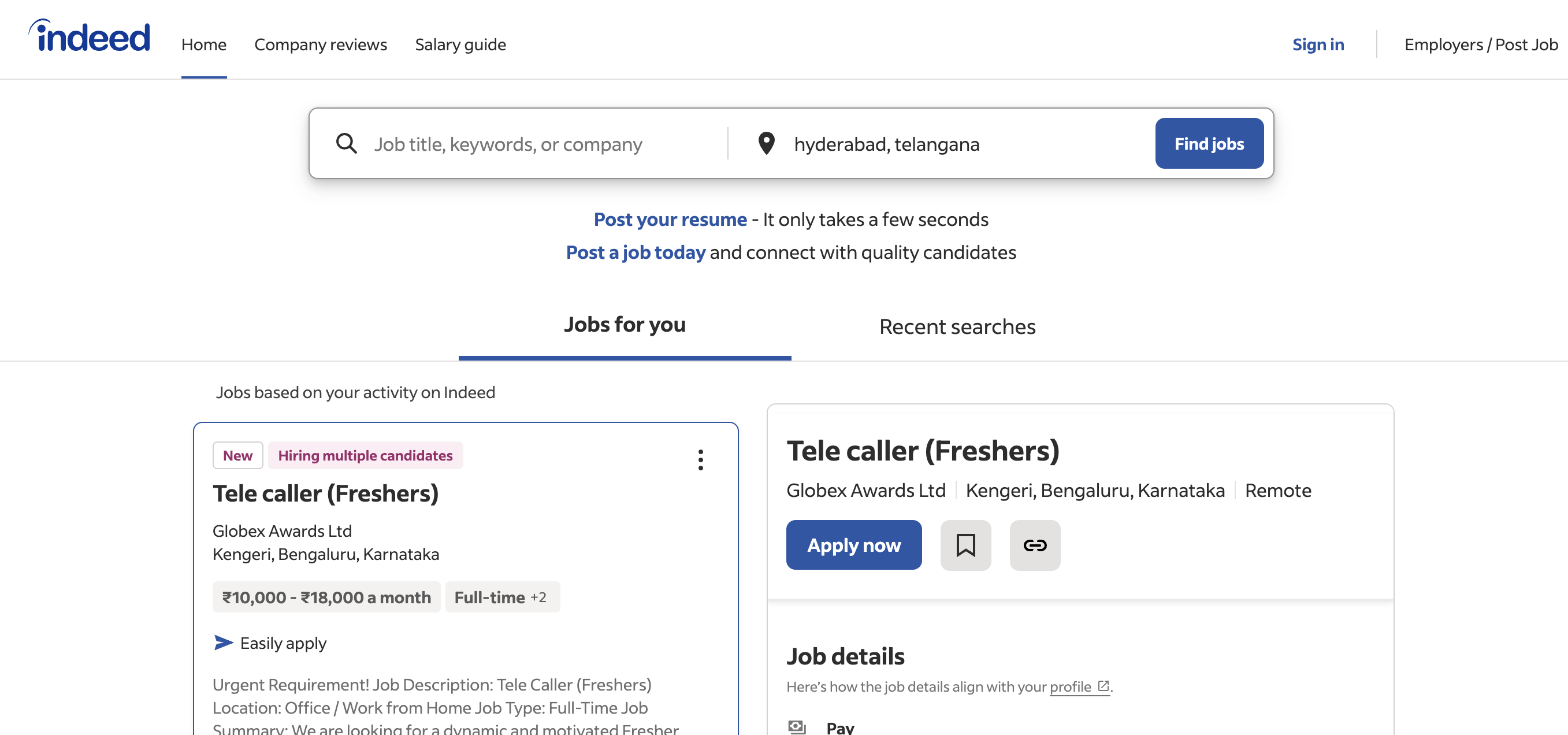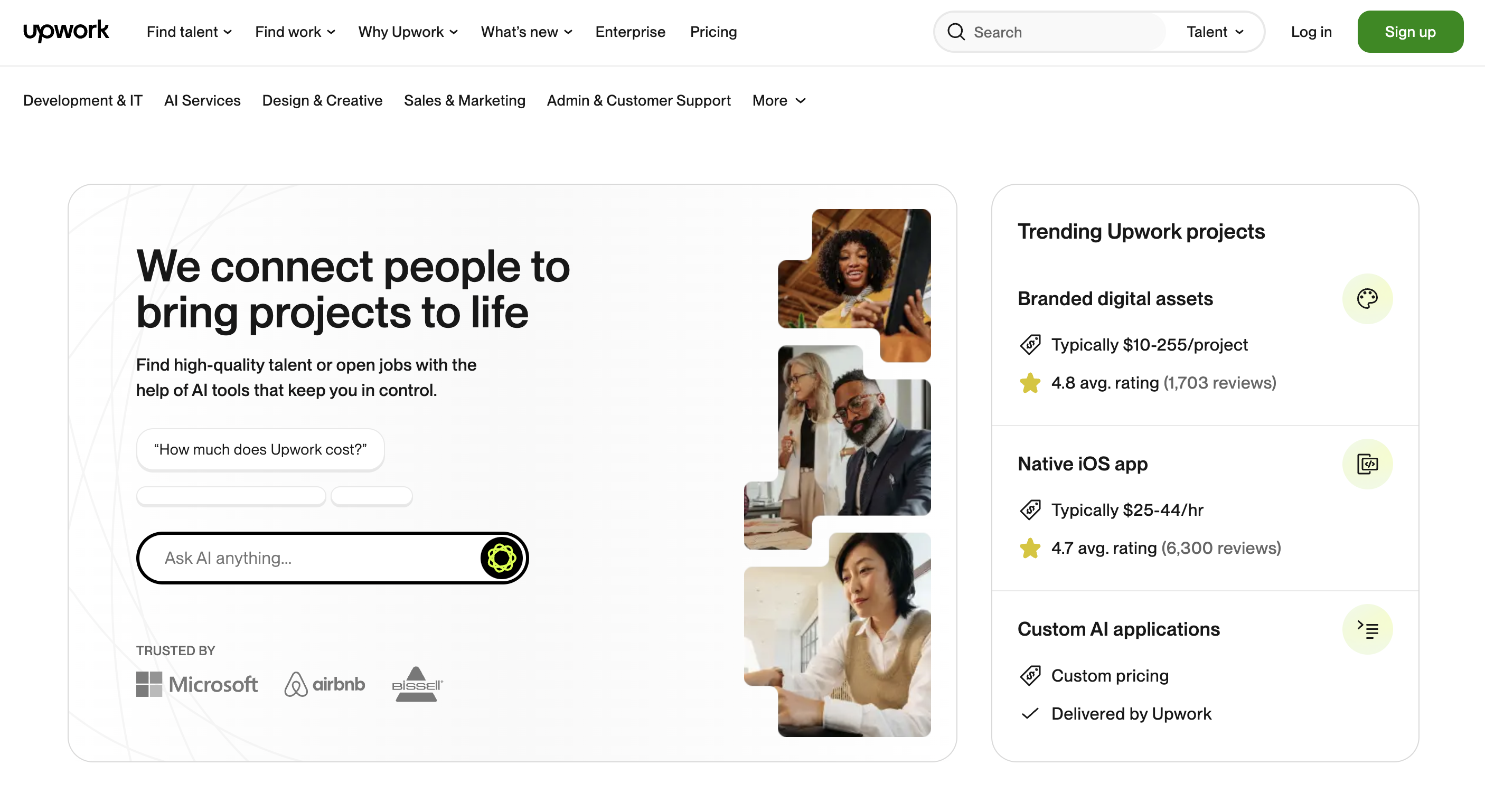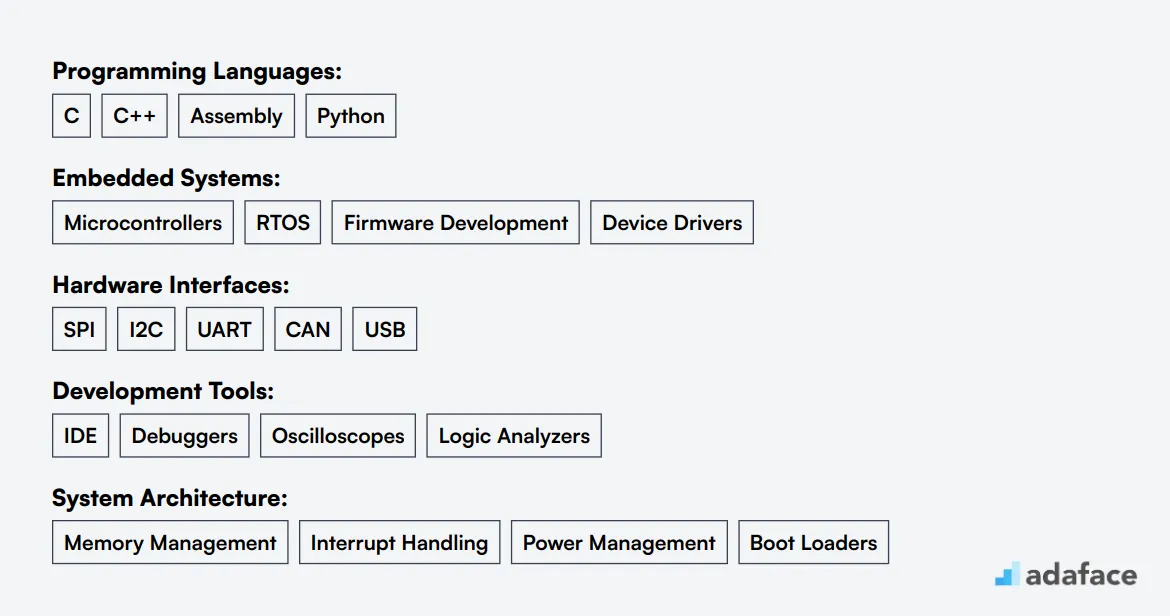Hiring embedded software engineers is a unique challenge for recruiters and hiring managers. These specialized professionals bridge the gap between hardware and software, requiring a distinct skill set that combines deep technical knowledge with practical application. Many companies struggle to find candidates who possess both the theoretical understanding and hands-on experience needed to excel in this role.
This comprehensive guide will walk you through the process of hiring top-notch embedded software engineers. We'll cover everything from understanding the role to crafting effective job descriptions, screening resumes, and conducting interviews. For a deeper dive into the specific skills required for this position, check out our detailed skills guide for embedded software engineers.
Table of contents
What Does an Embedded Software Engineer Do?
An Embedded Software Engineer designs and develops software that interacts directly with hardware components. They ensure that devices, from household appliances to industrial machines, operate smoothly and securely by writing code that controls the hardware functions.
Embedded Software Engineers typically have a variety of tasks that keep them engaged and challenged each day. They often partake in:
- Writing and testing code that runs on devices to ensure proper functionality.
- Collaborating with hardware engineers to understand requirements and specifications.
- Debugging and troubleshooting to identify and fix issues in the software or hardware integration.
- Documenting software processes to maintain clarity and assist future development.
For more insights into the skills required for an Embedded Software Engineer, visit our detailed guide.
Embedded Software Engineer Hiring Process
Hiring an Embedded Software Engineer requires a structured approach to identify the best candidates who can handle the nuances of embedded systems. Here's a streamlined process to guide you.
- Craft a detailed job description: Start by outlining the specific skills and experience you need. You can refer to Embedded Software Engineer job description for insights.
- Advertise the position: Post the job on relevant platforms and expect an influx of resumes within the first week.
- Screen resumes and shortlist candidates: Focus on key qualifications such as experience with embedded systems, programming skills, and previous projects.
- Conduct technical assessments: Use skill assessments and coding tests to evaluate the candidates' technical abilities. This step usually takes about a week.
- Interview top candidates: Move shortlisted candidates to the interview stage to assess their problem-solving skills and cultural fit.
- Make an offer: Once the best candidate is identified, proceed to extend a job offer.
The entire hiring process can span 4-6 weeks, depending on your pace. Quick and clear communication is key at every step to keep candidates engaged. In the following sections, we'll dive deeper into each stage with detailed tips and resources.
Skills and qualifications for an Embedded Software Engineer
Creating a candidate profile for an Embedded Software Engineer can be tricky. The role often requires a unique blend of software and hardware expertise. Here's a guide to help you distinguish between must-have skills and preferred qualifications for your specific needs.
Required skills typically include a strong foundation in computer science or electrical engineering, proficiency in C/C++, and experience with microcontroller programming. Familiarity with real-time operating systems (RTOS) and hardware interfaces is also key.
Preferred qualifications might encompass embedded Linux development, FPGA programming, or expertise in low-power design techniques. These can vary based on your project requirements and team structure.
Remember, the ideal candidate should demonstrate not just technical prowess, but also problem-solving abilities and a keen interest in staying updated with emerging embedded technologies.
| Required skills and qualifications | Preferred skills and qualifications |
|---|---|
| Bachelor's degree in Computer Science, Electrical Engineering, or related field | Experience with embedded Linux development |
| Proficiency in C/C++ programming languages | Knowledge of version control systems (e.g., Git) |
| Experience with microcontroller programming and embedded systems | Familiarity with debugging tools and techniques for embedded systems |
| Understanding of real-time operating systems (RTOS) | Experience with FPGA programming |
| Familiarity with hardware interfaces and communication protocols (e.g., SPI, I2C, UART) | Understanding of low-power design techniques |
How to write an Embedded Software Engineer job description?
Once you've defined the ideal candidate profile, the next step is to articulate that information in a job description that attracts the right talent. A well-crafted job description can significantly impact the quality of applicants you receive.
- Highlight key responsibilities and impact: Clearly outline the specific responsibilities of the embedded software engineer role, including tasks like designing software for embedded systems, debugging, and testing. Emphasizing how their contributions will enhance product performance can engage candidates looking for meaningful work.
- Balance technical skills with soft skills: While it's important to detail technical requirements such as proficiency in C/C++, real-time operating systems, and hardware-software integration, don’t forget to mention soft skills like teamwork and communication. A diverse skill set attracts well-rounded engineers who can thrive in collaborative environments.
- Showcase the unique selling points of your company: What makes your organization different? Whether it’s innovative projects, a commitment to professional development, or a dynamic work culture, highlighting these aspects can help you stand out and attract top-tier candidates. For more details on specific responsibilities and qualifications, refer to the embedded software engineer job description.
10 platforms to hire Embedded Software Engineers
Now that we have a job description, it’s important to list it on various job sites to source candidates effectively. Using the right platforms can help you reach qualified embedded software engineers who meet your specific requirements.
LinkedIn is a professional networking site where you can reach out to potential full-time candidates with diverse skill sets, including embedded software engineers.

Indeed
Indeed is one of the largest job listing sites, allowing you to post job openings and reach a wide audience for full-time positions.

Upwork
Upwork is a platform for hiring freelance professionals, ideal for short-term or project-based hiring of embedded software engineers.

Here are three platforms to consider: LinkedIn is a professional networking site where you can connect with full-time candidates. Indeed is one of the largest job listing sites, ideal for posting full-time positions. Upwork caters to freelance professionals, perfect for short-term hires.
In addition to these, platforms like FlexJobs focus on remote opportunities, while Glassdoor provides job listings along with company reviews. For startups, AngelList is an excellent choice, while tech-focused sites like Hired specialize in connecting employers with vetted candidates. Furthermore, Remote OK and Toptal offer options for remote and freelance embedded software engineers.
How to Screen Embedded Software Engineer Resumes
Screening resumes is the first step in finding the right Embedded Software Engineer. With a large number of applicants, it's important to narrow down the candidates to those who fit the requirements and skills needed for this specialized role.

When manually screening resumes, focus on key skills like C/C++ programming, microcontroller programming, and knowledge of real-time operating systems (RTOS). Look for keywords related to hardware interfaces such as SPI, I2C, and UART, and evaluate the candidate's experience with embedded systems. This initial screening helps you filter out resumes that do not align with your needs.
You can also enhance your resume screening with AI tools. These tools can quickly sift through large volumes of resumes, highlighting key qualifications and skills that match your job description. Consider using platforms like Adaface's online assessment platform to make the process more effective.
Here's a sample prompt you can use with an AI tool to screen resumes:
TASK: Screen resumes to match job description for Embedded Software Engineer role
INPUT: Resumes
OUTPUT: For each resume, provide the following information:
- Email id
- Name
- Matching keywords
- Score (out of 10 based on keywords matched)
- Recommendation (detailed recommendation of whether to shortlist this candidate or not)
- Shortlist (Yes, No, or Maybe)
RULES:
- If you are unsure about a candidate's fit, put the candidate as Maybe instead of No
- Keep recommendation crisp and to the point.
KEYWORDS DATA:
- Programming Languages (C, C++)
- Embedded Systems (Microcontrollers, RTOS)
- Hardware Interfaces (SPI, I2C, UART)
- Tools (Git, Debuggers)
Using these techniques, you can streamline the hiring process and focus on candidates who are more likely to be a good fit. For more on effective recruitment strategies, check out our tech recruitment blog.
Recommended skills tests for Embedded Software Engineers
Skills tests are an effective way to evaluate Embedded Software Engineers beyond their resumes. They provide objective insights into a candidate's technical abilities and problem-solving skills. Here are five key tests we recommend for assessing Embedded Software Engineer candidates:
Embedded C Test: This Embedded C test evaluates a candidate's proficiency in writing code for embedded systems. It assesses their ability to work with microcontrollers, manage memory constraints, and implement real-time operations.
C Programming Test: A solid foundation in C is critical for embedded systems. The C programming test checks a candidate's knowledge of syntax, pointers, memory management, and standard libraries essential for embedded development.
Data Structures Test: Efficient data handling is key in resource-constrained environments. The Data Structures test assesses a candidate's ability to implement and use various data structures optimally in embedded systems.
Linux Test: Many embedded systems run on Linux-based operating systems. A Linux test helps evaluate a candidate's familiarity with the Linux environment, command-line operations, and kernel-level concepts.
Software System Design Test: Embedded systems often require careful architectural planning. The Software System Design test assesses a candidate's ability to design scalable and maintainable embedded software architectures.
Recommended Case Study Assignments to Screen Embedded Software Engineers
Case study assignments can be a great tool to assess an embedded software engineer's skills, but they come with challenges. These assignments are often lengthy, leading to low completion rates and a chance of losing good candidates. However, when designed well, they provide deep insights into a candidate's capabilities. Below are some sample case studies that could be effective for this role.
- Real-Time System Design: This case study involves designing a system that meets specific real-time constraints, such as processing speed or response time. This allows you to gauge a candidate’s understanding of real-time systems, which is crucial for embedded systems. Explore more on relevant system design interview questions.
- Memory Management Optimization: Here, candidates work on optimizing an embedded system for limited memory resources. This assignment helps assess their ability to design memory-efficient systems, a necessity in environments with constrained resources.
- Peripheral Integration: In this task, candidates integrate various peripherals with a microcontroller and demonstrate their ability to handle hardware interfaces. This case study is ideal for understanding a candidate's proficiency in dealing with hardware, a key aspect of embedded software engineering.
How to Structure the Interview Stage for Hiring Embedded Software Engineers
Once candidates pass the initial skills tests, the next step is a technical interview to thoroughly assess their hard skills. Skills tests are great for filtering out unqualified applicants but might not always identify the best fit for the role. Therefore, a well-structured interview process is crucial to evaluate candidates' abilities in real-world scenarios and ensure they can meet the job's specific demands.
To effectively assess candidates, consider asking questions that reveal their problem-solving abilities and technical knowledge. Here are some examples:
- Explain how you would debug a memory leak in embedded systems.
- Describe your experience with embedded C programming. Read more about embedded C interview questions.
- Can you discuss the importance of RTOS in embedded systems?
- How do you handle hardware-software integration issues?
- Describe a challenging project you've worked on and how you overcame any obstacles.
These questions help gauge candidates' practical experience and their capability to handle scenarios they might face in the role.
Hire the Best Embedded Software Engineers
We've covered the role of Embedded Software Engineers, the hiring process, key skills, and effective screening methods. From crafting precise job descriptions to conducting technical interviews, each step plays a part in finding the right candidate for your team.
The key takeaway is to use well-crafted job descriptions and skills tests to make your hiring process more accurate. By focusing on these elements, you'll be better equipped to identify and attract top Embedded Software Engineering talent that fits your specific needs.
Embedded C Online Test
FAQs
Key skills include proficiency in C/C++, knowledge of microcontrollers and real-time operating systems, understanding of hardware interfaces, debugging skills, and familiarity with development tools and version control systems.
Look for candidates with relevant educational backgrounds in computer science or electrical engineering, experience with embedded systems, and projects demonstrating hands-on skills with microcontrollers and low-level programming.
Consider using coding tests focused on C/C++, embedded systems design challenges, and assessments covering topics like real-time operating systems, interrupt handling, and hardware interfaces. Our embedded C online test is a great starting point.
Start with a technical phone screen, followed by a coding challenge or take-home project. Then conduct on-site interviews including technical discussions, system design questions, and behavioral interviews to assess both technical skills and cultural fit.
Look on specialized job boards like EmbeddedJobs.com, attend industry conferences and meetups, leverage LinkedIn and GitHub for passive candidates, and consider partnering with universities that have strong embedded systems programs.
Focus on specific technical requirements, desired experience with relevant tools and platforms, and any industry-specific knowledge. Highlight interesting projects and the impact of the role. For guidance, check our embedded software engineer job description template.
Avoid overlooking candidates without traditional backgrounds, focusing too much on specific tool experience rather than fundamental skills, neglecting to assess problem-solving abilities, and failing to evaluate candidates' ability to work within hardware constraints.

40 min skill tests.
No trick questions.
Accurate shortlisting.
We make it easy for you to find the best candidates in your pipeline with a 40 min skills test.
Try for freeRelated posts
Free resources



